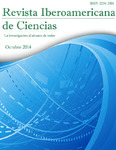
Please use this identifier to cite or link to this item:
http://ricaxcan.uaz.edu.mx/jspui/handle/20.500.11845/565Full metadata record
| DC Field | Value | Language |
|---|---|---|
| dc.contributor | 76919 | es_ES |
| dc.creator | Heredia Solis, Alejandra | - |
| dc.creator | Esparza Ibarra, Edgar León | - |
| dc.creator | Romero Bautista, Leticia | - |
| dc.creator | Cabral Arellano, Francisco Javier | - |
| dc.creator | Bañuelos Valenzuela, Romulo | - |
| dc.date.accessioned | 2018-06-18T19:00:44Z | - |
| dc.date.available | 2018-06-18T19:00:44Z | - |
| dc.date.issued | 2014-10 | - |
| dc.identifier | info:eu-repo/semantics/publishedVersion | es_ES |
| dc.identifier.issn | 2334-2501 | es_ES |
| dc.identifier.uri | http://hdl.handle.net/20.500.11845/565 | - |
| dc.description | Mezcal industry in Zacatecas-Mexico produces about 600 tons per month of lignocellulosic residues from Agave salmiana and Agave weberi bagasse, both were evaluated for the production of edible mushroom Pleurotus ostreatus. The proxymal analysis, chemical composition and elemental analysis showed a content of 3.70% and 3.17% for protein, 5559 mg / L and 3.23 mg / L for total reducing sugars, 0.73% and 0.54% total nitrogen, 3.46% and 1.95% calcium; on bagasse of A. salmiana and A. weberi, respectively. The biological efficiency was 70% in A. salmiana bagasse and 40% in A. weberi bagasse, the use of these residues for the cultivation of P. ostreatus is feasible. | es_ES |
| dc.description.abstract | La industria del mezcal en Zacatecas-México produce alrededor de 600 toneladas mensuales de residuos lignocelulósicos a partir del bagazo de Agave salmiana y Agave weberi, ambos fueron evaluados para la producción del hongo comestible Pleurotus ostreatus. Los análisis bromatológico, de composición química y análisis elemental mostraron un contenido de 3.70% y 3.17% para proteínas, 5559 mg/L y 3.23 mg/L para azucares reductores totales, 0.73% y 0.54% de nitrógeno total, 3.46% y 1.95% de calcio; en bagazos de A. salmiana y A. weberi, respectivamente. La eficiencia biológica fue del 70% en el bagazo de A. salmiana y del 40% en el bagazo de A. weberi, siendo factible el uso de estos residuos para el cultivo de P. ostreatus. | es_ES |
| dc.language.iso | spa | es_ES |
| dc.publisher | Revista Iberoamericana de Ciencias | es_ES |
| dc.relation.uri | generalPublic | es_ES |
| dc.rights | Atribución-NoComercial-CompartirIgual 3.0 Estados Unidos de América | * |
| dc.rights.uri | http://creativecommons.org/licenses/by-nc-sa/3.0/us/ | * |
| dc.source | Revista Iberoamericana de Ciencias, Vol. 1, Núm 5, 2014. | es_ES |
| dc.subject.classification | BIOLOGIA Y QUIMICA [2] | es_ES |
| dc.subject.other | Hongos comestibles | es_ES |
| dc.subject.other | maguey | es_ES |
| dc.subject.other | mezcal | es_ES |
| dc.subject.other | residuos lignocelulósicos | es_ES |
| dc.title | Bagazos de Agave salmiana y Agave weberi utilizados como sustrato para producir Pleurotus ostreatus | es_ES |
| dc.type | info:eu-repo/semantics/article | es_ES |
| Appears in Collections: | *Documentos Académicos*-- UA Ciencias Biológicas | |
Files in This Item:
| File | Description | Size | Format | |
|---|---|---|---|---|
| 2014 Revista Iberoamericana de Ciencias.pdf | 1,08 MB | Adobe PDF |  View/Open |
This item is licensed under a Creative Commons License
